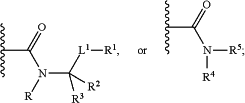| CPC C07D 487/10 (2013.01) [C07D 519/00 (2013.01)] | 38 Claims |
|
1. A compound, wherein the compound is of Formula I:
 or a pharmaceutically acceptable salt thereof, wherein:
 RA is
L1 is a covalent bond or a saturated or unsaturated, straight or branched, optionally substituted bivalent C1-6 hydrocarbon chain, wherein 0-2 methylene units of L1 are independently replaced by —O—, —NR—, —S—, —OC(O)—, —C(O)O—, —C(O)—, —S(O)—, —S(O)2—, —C(S)—, —NRS(O)2—, —S(O)2NR—, —NRC(O)—, —C(O)NR—, —OC(O)NR—, —NRC(O)O—, or —NRC(O)NR—;
R1 is hydrogen, an optionally substituted C1-6 aliphatic group, or an optionally substituted cyclic group selected from a 3-8 membered saturated or partially unsaturated monocyclic carbocyclic ring, a 7-12 membered saturated or partially unsaturated bicyclic carbocyclic ring, phenyl, an 8-10 membered bicyclic aromatic carbocyclic ring, a 3-8 membered saturated or partially unsaturated monocyclic heterocyclic ring (having 1-2 heteroatoms independently selected from nitrogen, oxygen, and sulfur), a 7-12 membered saturated or partially unsaturated bicyclic heterocyclic ring (having 1-4 heteroatoms independently selected from nitrogen, oxygen, and sulfur), a 5-6 membered monocyclic heteroaromatic ring (having 1-4 heteroatoms independently selected from nitrogen, oxygen, and sulfur), and an 8-10 membered bicyclic heteroaromatic ring (having 1-5 heteroatoms independently selected from nitrogen, oxygen, and sulfur);
R2 is hydrogen, an optionally substituted C1-6 aliphatic group, —C1-6 alkylene-OR, —C1-3 alkylene-O—C1-3 alkylene-R, —C(O)OR, or —C(O)NR2; and R3 is hydrogen; or R2 and R3 together with the intervening carbon atom form an optionally substituted 3-7 membered saturated or partially unsaturated carbocyclic ring, or an optionally substituted 3-7 membered saturated or partially unsaturated heterocyclic ring (having 1-2 heteroatoms independently selected from nitrogen, oxygen, and sulfur);
R4 is an optionally substituted cyclic group selected from a 3-8 membered saturated or partially unsaturated monocyclic carbocyclic ring, a 7-12 membered saturated or partially unsaturated bicyclic carbocyclic ring, phenyl, an 8-10 membered bicyclic aromatic carbocyclic ring, a 3-8 membered saturated or partially unsaturated monocyclic heterocyclic ring (having 1-2 heteroatoms independently selected from nitrogen, oxygen, and sulfur), a 7-12 membered saturated or partially unsaturated bicyclic heterocyclic ring (having 1-4 heteroatoms independently selected from nitrogen, oxygen, and sulfur), a 5-6 membered monocyclic heteroaromatic ring (having 1-4 heteroatoms independently selected from nitrogen, oxygen, and sulfur), and an 8-10 membered bicyclic heteroaromatic ring (having 1-5 heteroatoms independently selected from nitrogen, oxygen, and sulfur); and R5 is hydrogen; or R4 and R5 together with the intervening nitrogen atom form an optionally substituted 4-7 membered saturated, or partially unsaturated heterocyclic ring (having 0-2 heteroatoms, in addition to the nitrogen, independently selected from nitrogen, oxygen, and sulfur), or an optionally substituted heteroaryl ring (having 0-3 heteroatoms, in addition to the nitrogen, independently selected from nitrogen, oxygen, and sulfur);
L2 is a saturated or unsaturated, straight or branched, optionally substituted bivalent C1-4 hydrocarbon chain, wherein 0-2 methylene units of L2 are independently replaced by —O—, —NR—, —C(O)O—, —C(O)—, —S(O)2—, or —C(O)NR;
R6 is an optionally substituted C1-6 aliphatic group, or a cyclic group selected from a 3-8 membered saturated or partially unsaturated monocyclic carbocyclic ring, a 7-12 membered saturated or partially unsaturated bicyclic carbocyclic ring, phenyl, an 8-10 membered bicyclic aromatic carbocyclic ring, a 3-8 membered saturated or partially unsaturated monocyclic heterocyclic ring (having 1-2 heteroatoms independently selected from nitrogen, oxygen, and sulfur), a 7-12 membered saturated or partially unsaturated bicyclic heterocyclic ring (having 1-4 heteroatoms independently selected from nitrogen, oxygen, and sulfur), a 5-6 membered monocyclic heteroaromatic ring (having 1-4 heteroatoms independently selected from nitrogen, oxygen, and sulfur), and an 8-10 membered bicyclic heteroaromatic ring (having 1-5 heteroatoms independently selected from nitrogen, oxygen, and sulfur), wherein the cyclic group is optionally substituted with one or more instances of R7;
each instance of R7 is independently halogen, —CN, —NO2, —OR, —SR, —NR2, —S(O)2R, —S(O)2NR2, —S(O)R, —S(O)NR2, —C(O)R, —C(O)OR, —C(O)NR2, —C(O)N(R)OR, —OC(O)R, —OC(O)NR2, —N(R)C(O)OR, —N(R)C(O)R, —N(R)C(O)NR2, —N(R)C(NR)NR2, —N(R)S(O)2NR2, —N(R)S(O)2R, an optionally substituted C1-6 aliphatic group, an optionally substituted C1-6 aliphatic-Cy group, or Cy;
L3 is a saturated or unsaturated, straight or branched, optionally substituted bivalent C1-4 hydrocarbon chain, wherein 0-2 methylene units of L3 are independently replaced by —O—, —NR—, —C(O)O—, —C(O)—, S(O)2—, or —C(O)NR;
R8 is a cyclic group selected from a 3-8 membered saturated or partially unsaturated monocyclic heterocyclic ring (having 1-2 heteroatoms independently selected from nitrogen, oxygen, and sulfur), a 7-12 membered saturated or partially unsaturated bicyclic heterocyclic ring (having 1-4 heteroatoms independently selected from nitrogen, oxygen, and sulfur), a 5-6 membered monocyclic heteroaromatic ring (having 1-4 heteroatoms independently selected from nitrogen, oxygen, and sulfur), and an 8-10 membered bicyclic heteroaromatic ring (having 1-5 heteroatoms independently selected from nitrogen, oxygen, and sulfur), wherein the cyclic group is optionally substituted with one or more instances of R9;
each instance of R9 is independently halogen, —CN, —NO2, —OR, —SR, —NR2, —S(O)2R, —S(O)2NR2, —S(O)R, —S(O)NR2, —C(O)R, —C(O)OR, —C(O)NR2, —C(O)N(R)OR, —OC(O)R, —OC(O)NR2, —N(R)C(O)OR, —N(R)C(O)R, —N(R)C(O)NR2, —N(R)C(NR)NR2, —N(R)S(O)2NR2, —N(R)S(O)2R, an optionally substituted C1-6 aliphatic group, an optionally substituted C1-6 aliphatic-Cy group, or Cy;
each Cy is independently an optionally substituted cyclic group selected from a 3-8 membered saturated or partially unsaturated monocyclic carbocyclic ring, phenyl, a 3-8 membered saturated or partially unsaturated monocyclic heterocyclic ring (having 1-2 heteroatoms independently selected from nitrogen, oxygen, and sulfur), and a 5-6 membered monocyclic heteroaromatic ring (having 1-4 heteroatoms independently selected from nitrogen, oxygen, and sulfur); and
each R is independently hydrogen, or an optionally substituted C1-6 aliphatic group, an optionally substituted phenyl, an optionally substituted 3-7 membered saturated or partially unsaturated carbocyclic ring, an optionally substituted 3-7 membered saturated or partially unsaturated heterocyclic ring (having 1-2 heteroatoms independently selected from nitrogen, oxygen, and sulfur), or an optionally substituted 5-6 membered heteroaryl ring (having 1-4 heteroatoms independently selected from nitrogen, oxygen, and sulfur); or
two R groups on the same nitrogen are taken together with their intervening atoms to form an optionally substituted 4-7 membered saturated, partially unsaturated, or heteroaryl ring (having 0-3 heteroatoms, in addition to the nitrogen, independently selected from nitrogen, oxygen, and sulfur);
wherein the compound is not 6-(1-benzyl-1H-pyrazole-4-carbonyl)—N-(3-(benzyloxy)-1-(methylamino)-1-oxobutan-2-yl)-2-(2,2-dimethylcyclopropane-1-carbonyl)-2,6-diazaspiro[3.4]octane-8-carboxamide.
|